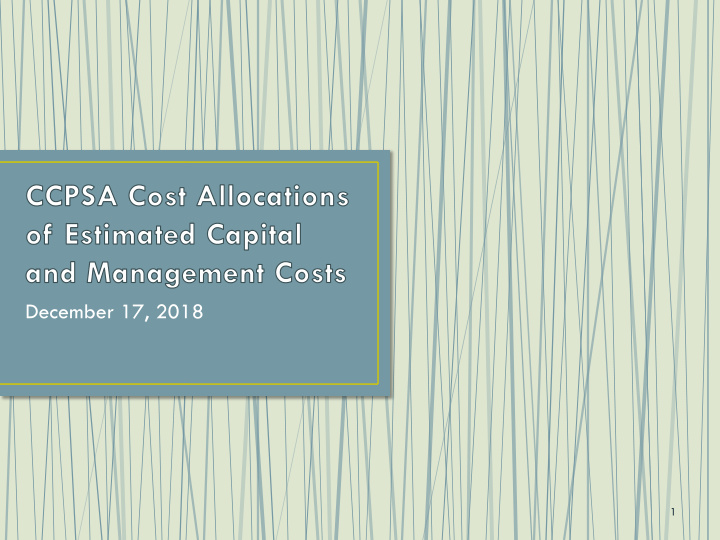



December 17, 2018 1
• This presentation discusses the allocation of capital and management costs • Next natural question after cost estimation • This is NOT an assessment, but rather would be voluntary “Initial Contributions,” assuming we want to begin operating dispatch service in FY 20 AND have CCPSA dispatch services begin in our communities more or less all at once under a centrally planned system vs. one by one combinations of dispatch over more time. 2
Outline • Distribution of Costs from Management and Capital Estimates • Change from incrementalism to central planning • Options if funding for central planning is not selected (budgeted or otherwise made available) 3
Distribution of Costs from Management and Capital Estimates • Annual Capital Costs: $262,660 • Half are new costs/half replace current local capital outlays • Annual Management Costs: $290,000 • Current Management cost is $400,953 • Total $552,660 years 1 and 2 • Total $307,184 year 3 onward • Net of PSAP revenue of $184,000 and mgmt. fee reduction of $70,000 4
5
• Each of our member communities will have to individually commit (through their management, board and public as locally appropriate) if they wish to budget or create contingencies for this new external funding in FY 20. If our communities do not commit, we cannot move forward with the “final planning with phased implementation approach” in FY 20. • As soon as we know whether or not member communities have budgeted or created contingencies for FY 20 in the above amounts, we can examine whether or not we have the support to continue with the centrally planned approach or must move back to a more private sector approach of incrementalism. 6
Change from incrementalism to central planning Prior to public vote “incremental approach” was endorsed by the Public Safety Chiefs, Joint • Survey Committee (pre-cursor to the CCPSA Board), the Governance Group which pre-dated the Joint Survey Committee, included in DeltaWRX reports, included in the CCPSA Agreement and the MOA on funding. The incremental approach--growing dispatch by combining dispatch one community at a time • addressed concerns of the public safety chiefs given the need to stand up a center in a phased controlled manner. Later it became clear that models our consultant found for evolution into regional dispatch were • completed by either a true county government or a “host agency” local government to house the regional dispatch entity. Regional dispatch was typically not a true regional government, but part of an existing local government which provided financing, executive leadership, human resources, IT, finance, buildings, procurement and other key support functions. Given those concerns, the effort up to and including the public information to support the vote • included the concept of incrementalism. Incrementalism as described in prior documents: • 1) Minimal expansions in operating costs • 2) Recycling equipment, reducing capital costs • 3) Incremental expansions in use of existing radio infrastructure and dispatching policies to cover more and more public safety agencies • 4) Savings in staff to occur with attrition of staff over time • 5) An iterative approach of operations planning, testing, training, and improvement for each community’s 7 onboarding (receiving dispatch service)
Change from incrementalism to central planning After public vote key themes emerged: • Create a central plan for the entire system now that the partners were known as voiced by their voters • Become a PSAP soon to realize savings in transfer times and improvements to public safety • Combine the five dispatch centers more quickly than previously considered (originally over a 2-3 year time frame) • Have all of our communities receive dispatch services from regional dispatch quickly 8
Options: incrementalism and central planning Realizations • Central Planning would be quicker • Central Planning costs more, and all at once Impacts • What will change in FY 21 vs. FY 20 • Effort could go stale if we don’t start providing dispatch service soon • Changes in public safety chiefs and City/Town management • Can Consultant hold for a year? Decisions • Do we want to or can we pay the costs of central planning? Choices Determine if communities want to wait a year and see if they are willing to • budget these amounts in FY 21, which will place IXP and the entire effort on hold for a year Move forward under the incremental approach--growing dispatch service by • one community at a time-- but informed by the information IXP will have provided under their initial (item A) consulting effort. 9
Recommend
More recommend